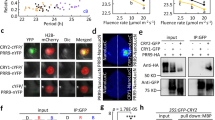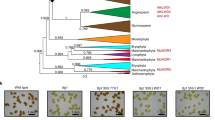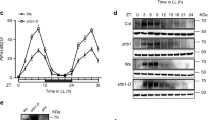Abstract
The circadian system regulates 24-hour biological rhythms1 and seasonal rhythms, such as flowering2. Long-day flowering plants like Arabidopsis thaliana, measure day length with a rhythm that is not reset at lights-off3, whereas short-day plants measure night length on the basis of circadian rhythm of light sensitivity that is set from dusk2. early flowering 3 (elf3) mutants of Arabidopsis are aphotoperiodic4 and exhibit light-conditional arrhythmia5,6. Here we show that the elf3-7 mutant retains oscillator function in the light but blunts circadian gating of CAB gene activation, indicating that deregulated phototransduction may mask rhythmicity. Furthermore, elf3 mutations confer the resetting pattern of short-day photoperiodism, indicating that gating of phototransduction may control resetting. Temperature entrainment can bypass the requirement for normal ELF3 function for the oscillator and partially restore rhythmic CAB expression. Therefore, ELF3 specifically affects light input to the oscillator, similar to its function in gating CAB activation, allowing oscillator progression past a light-sensitive phase in the subjective evening. ELF3 provides experimental demonstration of the zeitnehmer (‘time-taker’) concept7,8.
This is a preview of subscription content, access via your institution
Access options
Subscribe to this journal
Receive 51 print issues and online access
$199.00 per year
only $3.90 per issue
Buy this article
- Purchase on Springer Link
- Instant access to full article PDF
Prices may be subject to local taxes which are calculated during checkout




Similar content being viewed by others
References
Dunlap, J. C. Molecular bases for circadian clocks. Cell 96, 271–290 (1999).
Lumsden, P. J. in Biological Rhythms and Photoperiodism in Plants (eds Lumsden, P. J. & Millar, A. J.) 167–181 (BIOS Scientific, Oxford, 1998).
Samach, A. & Coupland, G. Time measurement and the control of flowering in plants. BioEssays 22, 38 –47 (2000).
Zagotta, M. T., Shannon, S., Jacobs, C. & Meeks-Wagner, D. R. Early-flowering mutants of Arabidopsis thaliana. Aust. J. Plant Physiol. 19, 411–418 ( 1992).
Hicks, K. A. et al. Conditional circadian dysfunction of the Arabidopsis early-flowering 3 mutant. Science 274, 790– 792 (1996).
Reed, J. W. et al. Independent action of ELF3 and phyB to control hypocotyl elongation and flowering time. Plant Physiol. 122, 1149–1160 (2000).
Roenneberg, T. & Merrow, M. Molecular circadian oscillators: An alternative hypothesis. J. Biol. Rhythms 13, 167–179 (1998).
Merrow, M., Brunner, M. & Roenneberg, T. Assignment of circadian function for the Neurospora clock gene frequency. Nature 399, 584–586 (1999).
Millar, A. J. & Kay, S. A. Integration of circadian and phototransduction pathways in the network controlling CAB gene transcription in Arabidopsis . Proc. Natl Acad. Sci. USA 93, 15491 –15496 (1996).
Roenneberg, T. & Merrow, M. Circadian systems and metabolism. J. Biol. Rhythms 14, 449 –459 (1999).
Lakin-Thomas, P. L. Circadian rhythms: new functions for old clock genes? Trends Genet. 16, 135–142 ( 2000).
Somers, D. E. & Quail, P. H. Phytochrome-mediated light regulation of PHYA- and PHYB-GUS_ transgenes in Arabidopsis thaliana seedlings. Plant Physiol. 107, 523– 534 (1995).
Dowson-Day, M. J. & Millar, A. J. Circadian dysfunction causes aberrant hypocotyl elongation patterns in Arabidopsis. Plant J. 17, 63–71 ( 1999).
Millar, A. J., Carré, I. A., Strayer, C. A., Chua, N. H. & Kay, S. A. Circadian clock mutants in Arabidopsis identified by luciferase imaging. Science 267, 1161–1163 (1995).
Carré, I. A. & Kay, S. A. Multiple DNA–protein complexes at a circadian-regulated promoter element. Plant Cell 7, 2039–2051 ( 1995).
Bognar, L. K. et al. The circadian clock controls the expression pattern of the circadian input photoreceptor, phytochrome B. Proc. Natl Acad. Sci. USA 96, 14652–14657 (1999).
Millar, A. J., Short, S. R., Chua, N. H. & Kay, S. A. A novel circadian phenotype based on firefly luciferase expression in transgenic plants. Plant Cell 4, 1075– 1087 (1992).
Acknowledgements
R.M.B. was supported by a Gatsby graduate studentship; this work was supported by grants from the BBSRC to A.J.M.
Author information
Authors and Affiliations
Supplementary information
Rights and permissions
About this article
Cite this article
McWatters, H., Bastow, R., Hall, A. et al. The ELF3 zeitnehmer regulates light signalling to the circadian clock. Nature 408, 716–720 (2000). https://doi.org/10.1038/35047079
Received:
Accepted:
Issue Date:
DOI: https://doi.org/10.1038/35047079
This article is cited by
-
Environment-mediated mutagenetic interference on genetic stabilization and circadian rhythm in plants
Cellular and Molecular Life Sciences (2022)
-
The circadian clock ticks in plant stress responses
Stress Biology (2022)
-
Effects of different photoperiods on flower opening, flower closing and circadian expression of clock-related genes in Iris domestica and I. dichotoma
Journal of Plant Research (2022)
-
Regulation of flowering under short photoperiods based on transcriptomic and metabolomic analysis in Phaseolus vulgaris L.
Molecular Genetics and Genomics (2021)
-
Effect of small coding genes on the circadian rhythms under elevated CO2 conditions in plants
Plant Molecular Biology (2020)
Comments
By submitting a comment you agree to abide by our Terms and Community Guidelines. If you find something abusive or that does not comply with our terms or guidelines please flag it as inappropriate.



